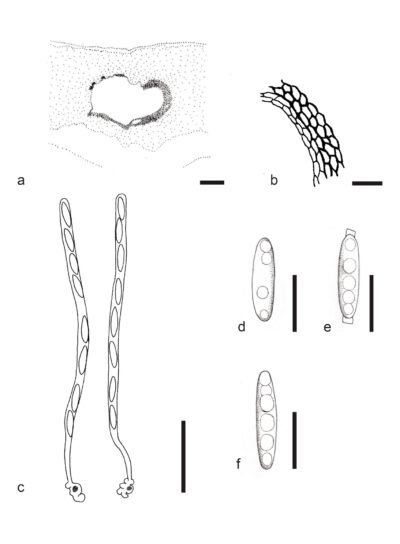Fungalpedia – Note 280, Paracapsulospora
Paracapsulospora S. Konta & K.D. Hyde
Citation when using this entry: Perera et al. 2024 (in prep) – Fungalpedia, genera described in 2016.
Index Fungorum, Facesoffungi, MycoBank, GenBank, Fig. 1
Classification: Incertae sedis, Incertae sedis, Sordariomycetidae, Sordariomycetes, Pezizomycotina, Ascomycota, Fungi
Hyde et al. (2016) introduced Paracapsulospora to accommodate a single species P. metroxyli, which is saprobic on dead Metroxylon in Thailand. Phylogenetic analysis of the LSU sequence data showed that Paracapsulospora related to both Magnaporthales and Amplistromatales. Due to limited sequence data availability, Paracapsulospora has not been assigned to an order and is left in Sordariomycetes incertae sedis (Hyde et al. 2016). The sexual morph of the genus is characterized by solitary, immersed, uniloculate, globose to subglobose ascomata surrounded by a dark brown layer of peridium cells. The peridium consists of black, thick-walled cells with textura angularis in the outside and hyaline, thin-walled cells inside. Asci are 8-spored, unitunicate, cylindrical with a long pedicel. Oblong to cylindrical and hyaline ascospores are arranging uni-seriately. They are bi-guttulate and aseptate, with thin and smooth walls and appendages with a distinct mucilaginous sheath. The asexual morph remains undetermined.
Type species: Paracapsulospora metroxyli Konta & K.D. Hyde
Other accepted species: This genus is monotypic
Figure 1 – Paracapsulospora metroxyli (MFLU 15-0704, holotype). a Section of ascoma. b Peridium. c Asci. d–f Ascospores. Scale bars: a = 100 μm, b = 10 μm, c = 20 μm, d–f = 5 μm. Redrawn from Hyde et al. (2016).
Reference
Entry by
Rekhani Hansika Perera, Center of Excellence in Fungal Research, Mae Fah Luang University, Chiang Rai, 57100, Thailand.
(Edited by Kevin D. Hyde, Samaneh Chaharmiri-Dokhaharani, & Achala R. Rathnayaka)
Published online 28 May 2024
